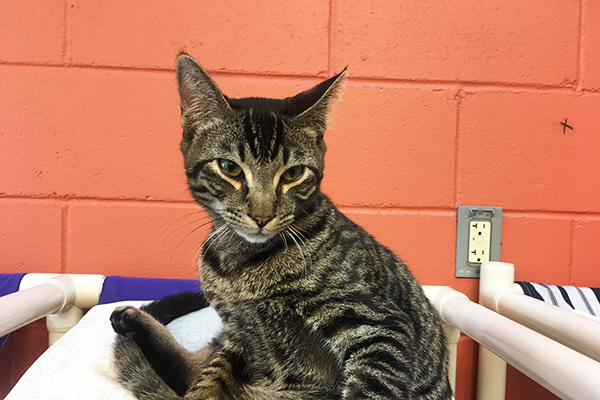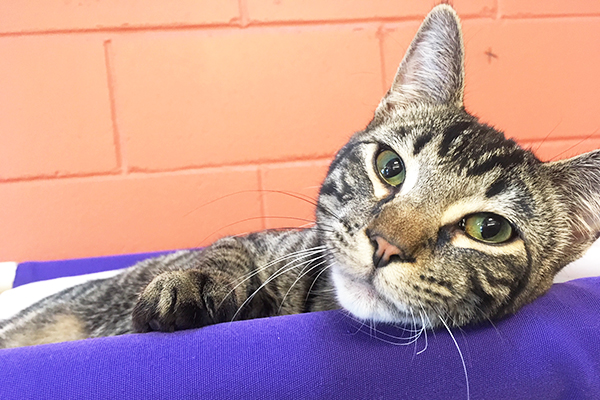Tabby cats (a.k.a. “tabbies”) possess a distinctive coat. It may seem like they are a breed unto themselves, but tabbies are not a breed. The term “tabby” refers to their striped fur pattern. Many tabby cats have the trademark “M” created by the stripes on the tabby’s forehead. Tabby kittens can get their fur patterns from either the sire or the dam, so the unique markings often emerge in the litters of cat fanciers’ breeding programs and those unplanned random cat romances. It is believed that a large percentage of feral cats are tabbies because the gene is so dominant and it’s most likely the dominant gene because the pattern is best suited for camouflage. There are quite a few varieties of tabby patterns (see all of them here!), but arguably the most popular is the mackerel tabby.

Holy mackerel — is that a tiger? All about the mackerel tabby cat pattern
Of all the tabby variations, the one most associated with traditional tabby markings is the mackerel tabby pattern. The mackerel tabby cat has stripes that run perpendicular to the cat’s spine and line his legs and ring his tail. They are sometimes referred to as “tiger cats” because their stripes resemble the only occurring-in-the-wild big cat with stripes, yes, Panthera tigris. While they may be referred to as tiger cats, the actual coat coloring of a tiger, an orange ground with black stripes, does not appear on Felis catus, or domestic cats. However, many cats of distinguished breeding boast the striking tabby coat: from the Norwegian Forest Cat to the Maine Coon.
So, a mackerel tabby cat pattern can appear on many different cat breeds and refers to the arrangement of stripes on the kitty’s body — specifically that the stripes run vertically down the cat off his spine. The stripes are often solid lines but they can be broken and they are born with them. This may seem like that’s all there is to know about tabbies, but read on!
Where did the name tabby cat, and the name mackerel tabby cat, come from?
According to the Merriam-Webster Dictionary, the term tabby originated from a type of silk taffeta with a wavy surface produced in Baghdad called ‘attābī, after the neighborhood it was created in. The French called it tabis and in the early 17th century, it made its way to English as tabby. It wasn’t until the late 18th century that the word tabby crossed over from describing a type of cloth to describing a type of cat. And once it made that leap, the quick-witted tabby left textiles in the dust!
The tiger-stripe tabby pattern was dubbed “mackerel” because the stripes coming off of the cat’s spine resemble a fish skeleton.
Fun facts about mackerel tabby cats
There are two notable mackerel tabby traits that help make him a real standout. The “M” — as mentioned — refers to the inverted chevron markings above his eyes. Is it a mask? Are they eyebrows? Folklore reports it could be from an Islamic prophet, a blessed virgin mother, or even an ancient sacred Egyptian icon. In reality, it’s probably just evolution.
The most prevalent nose color for tabbies is pink with a ring of black pigmentation, which can change.

Tabbitude — what’s up with tabby cats and their attitudes?
What about the infamous “tabbitude?” Every feline parent is familiar with the ubiquitous cattitude. And it’s reported that tabbies have it in spades. So, is there any truth in it?
I met a wonderful mackerel tabby named McGee at my local animal shelter, North Fork Animal Welfare League. McGee is outgoing, loving, and very playful — a bit too playful at times. He’d hop right up to the cat tower closest to your face, seeking copious amounts of affection. You’d be petting him and then chomp, probably just a little overstimulated. He wasn’t displaying any of the signs that he was an annoyed cat, he’d just get super excited; so excited that if you tried to move away from him, he’d jump down, rubbing his body against your legs.
Is McGee an ambassador for all mackerel tabbies? Not so fast! Gabrielle Stroup, shelter manager at NFAWL, says, “We have tabby cats come into our facility with a range of personalities. Many of them are from our community cat partners, where we take in the kittens from feral cats and adopt them out. In one litter, there are extremely friendly tabbies, extremely shy tabbies, and everything in between. These are kitties who have the same mother, most likely the same father, and are all nurtured in the same way.”
So ultimately, while tabbies are considered the cattiest of cats, this is probably untrue. “Cats are individuals, including tabbies,” says Stroup, quelling the rumors about the tabby ‘tude!
And, of course, they’re all individually lovable. Mackerel tabby McGee is now demanding attention from his adoring forever family. And just like the saying, “a tiger can’t change his stripes,” it’s impossible to resist the cuteness that’s at the core of all mackerel tabby cats.
Thumbnail: Photography ©Keren_J | Thinkstock.
Tell us: Do you have a mackerel tabby? We want to hear about him/her!
Read Next: Siamese Cats Are Temperature-Sensitive Albinos, a.k.a. Walking Heat Maps








